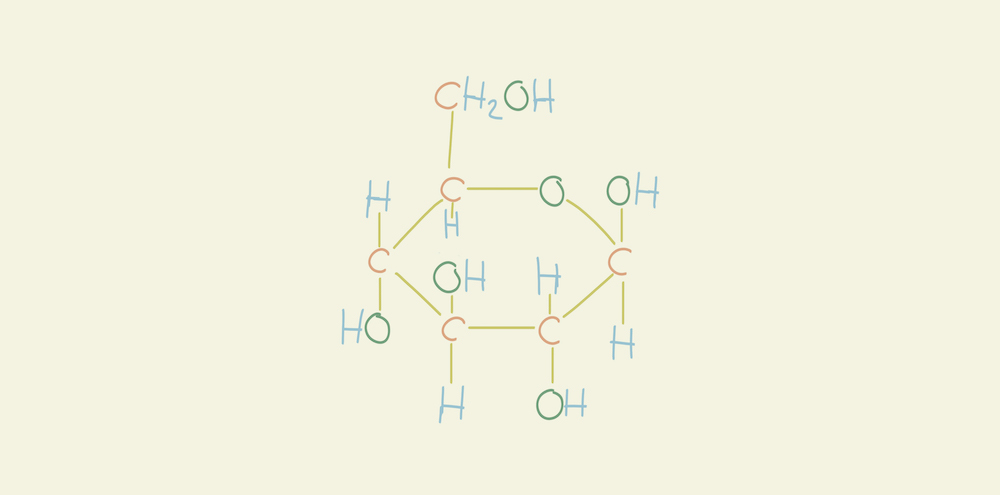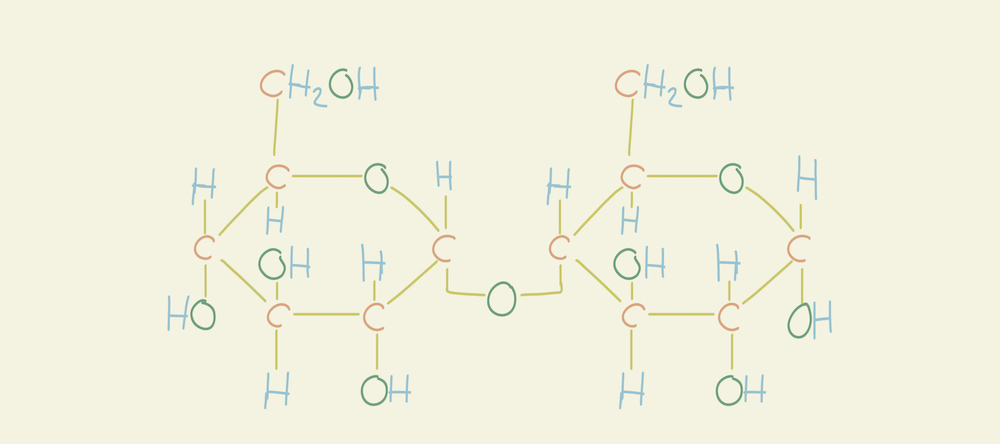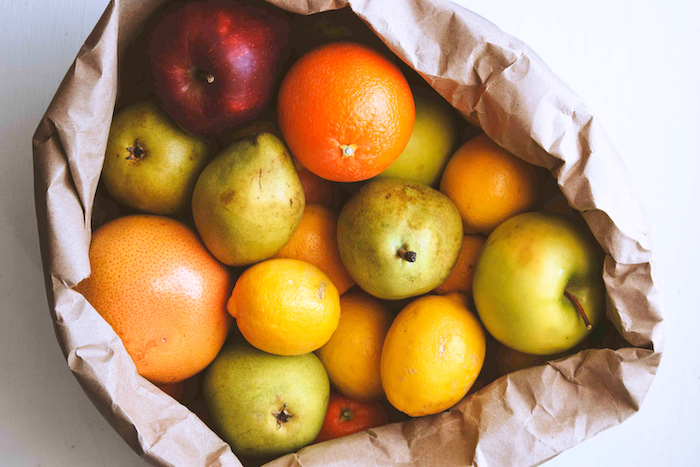Is fructose healthy or unhealthy? For a long time, fructose was considered to be the best substitute for table sugar for anyone with diabetes, but now this substitute has become very questionable: More and more people regularly suffer from digestive problems because they just can’t tolerate the large amounts of fructose in their food.
Fructose is not just sugar. Fructose, which occurs naturally in fruit, is now produced industrially on a large scale and added to numerous products. People consume this cheap form of sweetness mostly without even realizing it, and it can not only lead to fructose malabsorption, but also promote a number of diseases.
But what about the natural fructose in fruit? Even this is a little debatable. So we have taken a comprehensive look at the subject:
What ist fructose?
Fructose belongs to the group of carbohydrates. Chemically, all carbohydrates consist of carbon, oxygen and water. Depending on the number of sugar molecules, carbohydrates are divided into three groups:
- Single sugars (monosaccharides)
- Double sugars (disaccharides)
- Multiple sugars (polysaccharides)
Fructose is a simple sugar (monosaccharide). It gives fruits their natural sweetness and is also found in small amounts in vegetables, nuts, and legumes.

Household sugar, for example, also called sucrose, belongs to the group of double sugars and consists of one part glucose and one part fructose – or 50% of each. Compared to glucose, fructose has a particularly high sweetening quality, which is why it’s so popular in the food industry.

How is fructose metabolized?
Fructose, compared to glucose, has a minimal effect on blood sugar levels. While insulin helps transport glucose from the blood to the cells, meanwhile fructose goes straight to the liver through the blood. Once it’s in the liver, only a small amount of the fructose gets converted into glucose or glycogen (storage form). But the vast majority gets metabolized into fatty acids and is stored in the liver and other fat deposits in the body, which promotes the accumulation of body fat.
When we consume fructose, the pancreas hardly releases any insulin. Because the effect of fructose on blood sugar is so small, it’s also referred to as “insulin-independent” metabolism – so knowing this, it’s understandable that fructose was considered the ideal sweetener for diabetics for so long.
Fructose reaches the liver without any noticeable effect on blood glucose levels. In the liver, some of it is stored directly as fat and the rest enters the bloodstream in the form of fatty acids. From there, it moves on to the fat depots of our body.
How much fructose is healthy?
How much fructose is healthy for someone to consume can vary quite a bit from person to person, and depends on physical activity, lifestyle, and also the intestines’ ability to absorb it..
Good in natural compounds and measures
In the natural compound, or rather, in foods like fruits, vegetables, and nuts, fructose is healthy for the body in “normal” amounts. The natural foods that contain fructose have all kinds of benefits: they’re typically rich in fiber, antioxidants, vitamins and minerals, and phytonutrients.
Anthony William even describes the consumption of fruits as beneficial: fruits are easily digestible and the natural fruit sweetness, in combination with the fruit’s natural nutrient complex, has an effect on the body that’s equal parts energizing, nourishing, hydrating, and cleansing. He especially recommends the consumption of fruits in the morning without fats (to give the liver a break) and emphasizes again and again that there’s really no comparison between natural fructose and industrially copied “fruit sugar.”
Hybrid fruits and natural sweetness
Caution is advisable with hybrid fruits: Hybrid fruits, which are highly cultivated fruits that have artificially enhanced qualities like waxiness and sweetness, contain more fructose than the original version of the fruit, usually at the expense of nutrient richness. Dried fruits and natural sweeteners like agave syrup also contain relatively high levels of fructose. While they’re all better than white industrial sugar, they should also be enjoyed in moderation.
Popular ingredient of the industry
That being said, the majority of fructose that people consume does not come from natural sources. And this is exactly where the problem lies: nowadays, the average, uninformed citizen eats far too much “hidden fructose.” For a long time, the food industry has taken advantage of how tempting the sweetness of fructose can be. Since fructose is twice as sweet as glucose and thus provides a cheap option for sweetness, it’s incorporated in smaller or larger quantities in almost all products available in supermarkets, even the ones that don’t even necessarily taste sweet, like frozen pizza, sauces, and convenience foods. These products, along with candy, sweet baked goods, and sweetened soft drinks consumed in excess, are the reason many people experience problems coming from fructose.
The main source of hidden fructose is high-fructose corn syrup (HFCS). It can be found on the ingredient list under alternate names like fructose-glucose syrup or corn syrup. Because corn production is highly subsidized, HFCS is very cheap to produce
Industrially processed fructose comes in various forms and hides behind many names, including:
- High-Fructose-Corn-Sirup (HFCS)
- Fructose-glucose syrup
- Glucose-fructose syrup
- Corn syrup
- Invert sugar
- Invertose
- Fruit sweetener
- Fruit extract
- Molasses
- Sugar beet syrup
- Sugar cane juice
A healthy body is well equipped to consume normal amounts of fructose in the form of fruits and vegetables. But this hidden sweetness in so many industrial products is problematic.
Are you interessted in gaining a comprehensive understanding of the health benefits of a plant-based diet? Download the curriculum for our Holistic Nutrition Coach training program.

Too much fructose: effects on the body
Fructose consumption should always be considered in the context of your overall lifestyle: People who exercise, move a lot, and eat a natural diet are able to tolerate more fructose than people who eat a lot of industrial products and don’t exercise very much to boot.
In combination with an “unhealthy” lifestyle, fructose can promote a lot of diseases:
- On one hand, an excess of fructose can overload the intestine so much that fructose malabsorption, also known as fructose intolerance, happens as a result.
- On the other hand, too much fructose can have a negative effect on the metabolism and can lead to various diseases in the long run. The main reason for this is the conversion of fructose to fat in the liver.
In this context, it was recognized that the use of fructose as a sugar substitute in industrially manufactured foods as an ingredient in “diabetic foods” was not appropriate, and therefore fructose is no longer considered “diabetic-friendly.”
Too much fructose promotes:
Excess weight, obesity, and metabolic syndrome
Fructose causes weight gain in several ways
- Fructose is mostly converted to fatty acids in the liver and stored in the liver and the fat deposits throughout the body.
- Fructose inhibits the hormone leptin (1), an important substance for regulating the feeling of fullness. As a result, the brain never receives the message, “I am full.”
- Since the consumption of fructose does not make you feel full, it’s easy to eat more without really thinking about it, which burdens the liver. Interestingly, the pancreas then secretes more insulin to stimulate the liver to help it metabolize the fructose. However, as long as insulin is present in the blood, the body is not able to break down fat, since its counterpart glucagon would need to be active for this to happen. Glucagon promotes the breakdown of glycogen in the liver and the burning of fat. Thus, an excess of fructose indirectly prevents fat burning while simultaneously increasing fat formation. Possible consequences are excess weight gain, obesity, (2) and metabolic syndrome.
Metabolic syndrome consists of various diseases that happen one after the other as a result of hypercaloric nutrition and lack of exercise, and eventually form a disease composition. These include dyslipidemia, diabetes, visceral adipose tissue, hypertension, and atherosclerosis.
Increased uric acid levels, insulin resistance, gout and hypertension
Even though fruits are considered low in purines, when fructose is broken down in the liver, this creates a noticeable increase in purines, which then get further broken down into uric acid. This doesn’t happen with any other carbohydrate; fructose is the only sugar whose metabolism results in an increase in uric acid levels.
Elevated uric acid levels (hyperuricemia) promote the development of gout (3) and kidney stones, as well as a resistance to insulin (4). DElevated uric acid inhibits the formation of nitric oxide in blood vessels and may prevent proper blood flow to blood vessels in the muscles, as well as the proper function and effectiveness of insulin. This can also cause less flexibility in the vessel walls, which can result in increased blood pressure.
Increased blood lipid levels (especially triglycerides)
Fructose that’s been metabolized in the liver into fatty acids is transported via the blood to other fat depots in the body, which, on blood tests, can be reflected in elevated LDL cholesterol and blood fat levels (triglycerides) (5), Since elevated blood lipid levels promote vascular deposits (atherosclerosis), they’re a major risk factor for cardiovascular disease.
Fructose malabsorption
In common parlance, the term “fructose intolerance” is often used. But strictly speaking, there’s a distinction between the rare “hereditary” fructose intolerance, which is usually diagnosed in infancy, and fructose malabsorption, which develops throughout a person’s life.
One of the most common reasons for the development of fructose malabsorption is the long-term consumption of excessive amounts of fructose until the small intestine gets overloaded. Whatever can’t be passed on to the blood moves instead into the large intestine, where the resident bacteria try to break it down and digest it. However, since this isn’t actually part of their job, this results in digestive problems, like flatulence, a bloated belly and, worst case scenario, diarrhea.
In this case, it can help to completely avoid fructose for a while in order for the fructose transporters in the small intestine to regenerate. After about three to four weeks, fructose can be reintroduced in the form of low-fructose fruits like berries, slowly increasing the daily amount little by little.
While the body can’t tolerate any fructose at all with hereditary fructose intolerance, in the case of fructose malabsorption, which develops over time, the small intestine is typically still able to regenerate and absorb small amounts of fructose.
Dysbiosis and Leaky Gut
A large number of bacteria live in the large intestine in what’s called a “symbiosis.” They work hand in hand to digest long-chain carbohydrates and vitamins, and produce fatty acids. They maintain the ideal pH value for the intestine, and protect it from infections. The arrival of fructose disrupts this balance and alters the intestinal flora to allow pathogenic bacteria and fungi to multiply. Many people notice dysbiosis in the form of bloating, abdominal pain, diarrhea, chronic inflammatory processes, immune system weakness, as well as allergies resulting from a condition called leaky gut syndrome (7).
Non-alcoholic fatty liver
Another consequence of excessive fructose is the development of non-alcoholic fatty liver (8). This often happens unknowingly when too much hidden fructose in industrially manufactured products is constantly consumed.
For a more in-depth look at this particular issue, see the article, “How does non-alcoholic fatty liver develop?”“
After everything you’ve just read about fructose, if you’re now wondering how the 80/10/10 diet works, which is a raw vegan diet consisting mostly of ripe fruits, we recommend you read the blog article:
“How does the 80/10/10 diet work?”
🍋 🍊 🥭
Would you like to join our unique, based on nutritional sciences and practice-oriented training program for gaining a high level of health?
We are more than happy to inform you about our training program on our website!





0 Comments